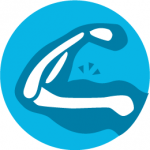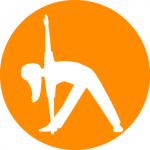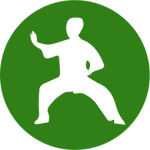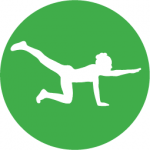Toe curls, squats, shoulder raises, wall angels, glute bridges…
These are just a few of the exercises for osteoporosis I’ve shared over the years. But which exercises go well together and how often should you do them?
In other words, what would a full workout routine for osteoporosis look like?
Great question. And one I’ve received several times over the past few months. So, I’ve put together a sample workout schedule that explains how you might use these exercises!
Now, there’s nothing hard and fast about this schedule. It’s just an example to help guide you, and you can (and should!) adapt it to suit your needs.
This is based on the optimal level of exercise for older adults, so of course, it may be a stretch to do this much right away. If that’s the case for you, start small. Pick one activity a week to try or even start with just a few minutes of stretching a day…
Remember, it’s not where you start that matters, it’s simply that you start. 🙂
Exercise Guidelines for Older Adults
The U.S. Department of Health recommends older adults do at least 150 to 300 minutes a week of moderate-intensity aerobic exercise.
Aerobic exercise means any activity where you’re moving for a sustained period of time, and your heart rate increases. For example, walking, dancing, Pilates, and even yard work count as aerobic activity. And as you can see, most aerobic exercise is also weight-bearing because your body is working against gravity.
So by engaging in just 2 hours and 30 minutes of aerobic exercise a week, you gain substantial health benefits— including bone health benefits!
Alternatively, you can do 75 to 150 minutes a week of high-intensity aerobic exercise, or a combination of moderate- and high-intensity exercise to meet the guidelines.
But note it’s preferable to spread your exercise throughout the week. That way, you won’t overextend yourself by pushing too hard in one session, and you’ll be more active on the daily.
The government also recommends adults do muscle-strengthening activities a couple days a week. Alongside weight-bearing exercise, muscle-strengthening activities are key for someone with low bone density.
(If you’d like more information on why these exercises are beneficial for bone health, visit our osteoporosis exercises page.)
The last piece of the puzzle is balance training and regular stretching. Now, this doesn’t have to be much. Just 10 minutes of simple balance exercises and gentle stretching a day can go a long way. Of course, balance exercises help reduce your risk of a fall, and stretching does too by keeping you limber and agile.
And there you have it! Based on the exercise guidelines for older adults, here’s what a well-balanced workout regimen might look like:
- 2 hours and 30 minutes of aerobic exercise a week
- 2 muscle-strengthening sessions a week
- A little bit of balance training and stretching daily
But what kinds of aerobic activities are best, what does a muscle-strengthening session entail, and which balance exercises and stretches should you be doing?
Here’s an example of a full workout routine for osteoporosis!
To make this schedule as easy as possible for you to use, we’ve put together a PDF version you can download. I encourage you to print it out, mark it up to your liking, stick it to your fridge, and follow along throughout the week.
*To download click on the icon in the top right corner and then click on download in the dropdown menu.
Weekly Workout Schedule for Osteoporosis

Monday: Full Body Muscle-Strengthening Workout

Muscle-strengthening exercise, also known as resistance-training, involves working against an opposing force like an elastic band, dumbbell, or your own body weight. And it’s helpful for osteoporosis because contracting your muscles also conditions your bones.
This example includes a variety of muscle-strengthening exercises to engage your full body. From your legs and core to your shoulders and arms, this workout effectively targets all the different muscle groups.
Note that you can easily swap these out for any of the muscle-strengthening exercises on our blog, or include exercises that we write about in the future. So if you have difficulty with any of these movements, feel free to choose an exercise more suited to your needs!
Here’s how to do this workout:
1. Low dumbbell row – 3 sets of 8 repetitions
For detailed instructions, visit our spinal exercises page.
2. Scaption – 3 sets of 10 repetitions
For detailed instructions, visit our shoulder exercises page.
3. Seated wrist curl with dumbbell – 3 sets of 10 repetitions
For detailed instructions, visit our wrist and forearm exercises page.
4. Glute bridge – 10-15 repetitions
For detailed instructions, visit our hip strengthening exercises page.
5. Push up with a resistance band – as many repetitions as is comfortable
For detailed instructions, visit our resistance band exercises page.
6. Lateral shoulder raise – 3 sets of 10 repetitions
For detailed instructions, visit our shoulder exercises page.
+ 5 minutes of stretching and/or balance exercises
These two exercises are a great complement to your muscle-strengthening workout for the day because they also work your core. And they both fall under the category of balance exercises for this reason! (As I mentioned earlier, a strong core is important for stability.)
Here are some examples:
Forearm plank – 3-5 repetitions
For detailed instructions and a video tutorial visit our planking exercises page.
Superwoman – 3 sets of 8 repetitions
For detailed instructions and a video tutorial visit our spinal exercises page.
Tailor this day to you:
There are easier and more advanced variations for all of these exercises. So no matter your fitness level, you should be able to find a variation that suits your needs. Simply follow the links above to find suggestions on how to tailor each exercise. And for the glute bridge, we even have a dedicated page that shows you how to do four variations for low bone density!

Tuesday: Aerobic Exercise
For day two, an aerobic exercise session will do the trick. This can be your choice of any number of activities. From a simple walk to spending some time in the garden to playing a sport, it’s up to you!
Of course, keep in mind these activities vary in intensity. You can use your target heart rate to determine whether an activity qualifies as moderate or vigorous intensity. For moderate activities, you should reach about 50-70% of your maximum heart rate. And for vigorous activities, it’s around 70-85% of your max rate.
For more information on how to calculate your optimal heart rate, visit the American Heart Association here!
Here are some examples:
+ 10-15 minutes of stretching and/or balance exercises
Once again, I recommend incorporating just a few minutes of stretching or balance exercises into your day. In fact, it’s a good idea to do some stretching before you engage in your aerobic activity of choice!
Here are some examples:
Toe splay – 10 repetitions with each foot
For detailed instructions and a video tutorial visit our foot strengthening exercises page.
Shoulder rolls – 10 repetitions
For detailed instructions and a video tutorial visit our posture exercises page.
Toe and heel raises – 15 repetitions
For detailed instructions and a video tutorial visit our balance exercises page.
Wall angels – 15 repetitions
For detailed instructions and a video tutorial visit our posture exercises page.
Tailor this day to you:
To meet the recommended amount of aerobic exercise a week while following this schedule, you’d need to do 50 minutes of your activity of choice. If that seems like a lot, don’t worry.
Remember, these guidelines are based on the ideal amount. But really, any amount of exercise is good for your health. So start with whatever length of time feels right for your body, and gradually work your way up!
Wednesday: Rest Day
Kick back, relax. You’re doing great!
Never feel guilty about taking a rest day either. Rest days are an important part of any exercise regimen. They give the body time to recover and prevent injury from overwork. But a rest day doesn’t mean spending the whole day on the couch either!
You should still move around, do some housework, go to the store… just moving around more in your day-to-day life can have a huge impact on your overall health.

Thursday: Aerobic Exercise
It goes without saying that you’re more likely to do an activity you enjoy than an activity that feels like work. So with your aerobic exercise days, try and find something you truly enjoy doing!
Do you love the peace that comes with tai chi? Or does getting out in nature inspire you? Whatever you enjoy most… do that!
Here are some examples:
+ 10-15 minutes of stretching and/or balance exercises
Feel free to mix and match the balance exercises and stretches in any of these sections. Depending on how you feel, you may want to focus on stretching one day, and save the balance exercises for a low-intensity workout day. Listen to your body and choose whichever movements suit your needs!
Here are some examples:
Toe extension – 10 repetitions with each foot
For detailed instructions and a video tutorial visit our foot strengthening exercises page.
Lateral wrist exercise – 3 sets of 10 repetitions with each wrist
For detailed instructions and a video tutorial visit our wrist and forearm exercises page.
One leg stand – 15 repetitions with each leg
For detailed instructions and a video tutorial visit our balance exercises page.
Head press – 10 repetitions
For detailed instructions and a video tutorial visit our posture exercises page.
Tailor this day to you:
You can adjust the length of time you engage in aerobic exercise, and you can also determine the intensity. A gentle aerobic activity like walking may be a good choice to start. If you find weight-bearing exercise difficult, you can even try a low-impact activity like water aerobics…
Now, land-based exercise is best for your bones, since your body is working against gravity. But water-based exercise does have slight bone health benefits too, and if physical activity is challenging for you, it can be a good place to start.

Friday: Full Body Muscle-Strengthening Workout
This is your final muscle-strengthening workout of the week! Since you’ve just completed two aerobic exercise days— and most aerobic activity engages the muscles in your legs— this second workout focuses on arm and shoulder strength.
Many of these exercises also engage your core. That is, the muscles in your midsection, including your abdominals, obliques, erector spinae (the group of muscles that run the length of your spine), and your glutes. And strengthening your core muscles is key because they work as stabilizers for your entire body!

1. Front squats – 3 sets of 12 repetitions
For detailed instructions, visit our resistance band exercises page.
2. Overhead press – 3 sets of 8 repetitions
For detailed instructions, visit our resistance band exercises page.
3. Triceps pushback – 3 sets of 8-10 repetitions
For detailed instructions, visit our spinal exercises page.
4. Alternating front dumbbell raise – 15 repetitions on each side
For detailed instructions, visit our shoulder exercises page.
5. Side leg raise – 15-20 repetitions on each side
For detailed instructions, visit our hip strengthening exercises page.
6. The clamshell – 15-20 on each side
For detailed instructions, visit our hip strengthening exercises page.
+ 10-15 minutes of stretching and/or balance exercises
These movements would be a great warm up for your muscle-strengthening workout, or you can do them as a cool down afterwards. You could also do them at a different time of day from your workout, like as part of your morning routine or before bed. Whatever feels best for you!
Here are some examples:
Towel curl – 10 repetitions with each foot
For detailed instructions and a video tutorial visit our foot strengthening page.
Tennis ball grip strength – 3 sets of 10 repetitions
For detailed instructions and a video tutorial visit our wrist and forearm exercises page.
Chair pose – 5 repetitions
For detailed instructions and a video tutorial visit our balance exercises post.
Doorway stretch – 2-3 repetitions on each side
For detailed instructions and a video tutorial visit our posture exercises page.
Tailor this day to you:
If you’re doing strength training for the first time, you may want to start small with one or two sets and work your way up to more. For more suggestions on how to adjust these movements to your fitness level, follow the links for each exercise above!

Saturday: Aerobic Exercise
Take a deep breath. You’re almost there!
You can choose any aerobic activity you like for the last active day of your regimen. To finish the week strong, opt for a more vigorous exercise like Pilates or barre.
Or if you’re feeling the weight of the week, choose something relaxing like a walk in the park. As always, it’s your call!
Here are some examples:
+ 10-15 minutes of stretching and/or balance exercises
This is your last balance and stretching session of the week, so make it count! These examples include some great leg and foot stretches to work out any tension from your aerobic exercise for the day.
Here are some examples:
Big toe stretch – 10 repetitions with each big toe
For detailed instructions and a video tutorial visit our foot strengthening exercises page.
Kneeling hip flexor – 10 repetitions on each side
For detailed instructions and a video tutorial visit our posture exercises page.
Calf stretch – 3-5 on each side
For detailed instructions and a video tutorial visit our foot strengthening exercises page.
Hip and back strengthener – 30 repetitions on each side
For detailed instructions and a video tutorial visit our balance exercises page.
Tailor this day to you:
Remember, you can mix and match any of the balance and stretching exercises throughout this post or on our blog. We also have full video series on our barre and Pilates pages you can follow along to fulfill your aerobic exercise requirement!
Sunday: Rest
Well done. That was hard work, and you did fantastic! Take the day to relax and reflect on how your week went.
Was there any activity you really enjoyed? What did you find more challenging: strength-training or aerobics? Which exercise did you feel like you benefitted the most from?
A little introspection can help you figure out what adjustments to make to get the most out of your routine in the future!
Osteoporosis Workout Takeaways
There’s no “one size fits all” when it comes to exercise.
Everybody has strengths and faces different challenges. So remember, this workout routine is simply an example.
You can mix and match the exercises in the muscle-strengthening workouts. And you can choose from any number of activities for aerobic days. You can start small and work your way up. Or if you’re more advanced, you can increase the length and intensity of any of these workouts!
Just listen to your body and don’t overdo it. And as always, it’s a good idea to talk to your healthcare provider before starting a new exercise regimen.
One last note, exercise doesn’t have to be limited to going to the gym or putting in your 30 minutes a day. Doing housework, walking to church, spending time in the garden— these day-to-day activities all count as physical activity.
Think of exercise as a gift you’re giving your body and your bones. Embrace it, choose activities you genuinely enjoy, and just move more on a daily basis.
Like I always used to tell my personal training clients, if you make your exercise regimen work for you, instead of seeing it as work, you’ll get a lot more out of it… and it’ll be a lot more enjoyable!





RS
August 31, 2019 , 7:26 amGood stuff. But I disagree. Over do it, with alignment.